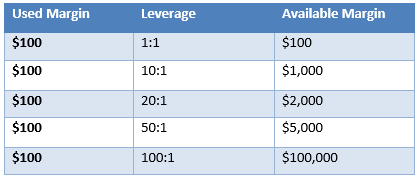Advertisement
Leverage Calculator
Use the leverage calculator to quickly find our how much leverage do you need to open a position
What is Forex Leverage?
Leverage is investing money with borrowed funds. Unlike a regular trade where you purchase a $10 item with $10, in Forex you can use leverage to buy (or sell) the same value with less funds, for example buy $10 with $1 margin (10:1 leverage).
Example leverage for a $100 account:
Leverage increases the potential of trading profits, however with increased leverage comes increased risk and therefore you can lose more.
Leverage is the ratio between the notional value of a trade and the currency used to open the trade, usually the domestic currency of the account. For example, a European trader will have a base currency of EUR while a US trader will have the base currency of USD.
The amount of leverage you use in your trading account determines the margin level you must maintain (otherwise you can get a margin call).
How to calculate leverage ratio?
A leverage ratio calculation is complex however with our forex leverage calculator you just need to input a few values and calculate it easily:
Currency pair - the currency you’re trading
Account currency - your account deposit currency
Margin - how much margin do you wish to use for the trade
Trade size - contract size or number of traded units (1 lots = 100,000 units)
Once calculated, you will see the exact leverage required to open the trade. Keep in mind that the leverage shown is the minimal leverage - a lower leverage will not allow to open the trade while a higher leverage can be used as long as your broker allows it.
How to calculate operating leverage?
The operating leverage is the effective leverage used in your account to hold the open positions.
In other words, it is the ratio between total net open positions to total margin on your deposit.
Effective or operating leverage cannot exceed the max leverage of your trading account.
For example: if you have an open EURUSD trade for 0.5 lot size and a deposit of 1000 EUR and used a margin of 50 EUR, this means your effective leverage is 1000/50=20. This means that every 10 EUR in value of the trading position is controlled by 5 EUR of your account balance.
How much leverage should I use?
That would depend on your risk tolerance. A leverage of 50:1 means that a change of 2% in price could wipe out your account (50*2=100%).
Don’t over leverage your positions and keep using a leverage that is suitable for your trading style. Usually a high leverage is used with small accounts or for short term trading methods such as scalping (as price fluctuation is limited) while long term trading systems such as trend-following (since price can fluctuate greatly) or large accounts use a lower leverage.
What leverage should I use?
That would depend on several factors:
- How much of your deposit are you willing to lose?
- Do you have a working and successful trading system?
- Are you trading full time or just as a hobby?
You have probably heard of the phrase - “never invest money that you can’t afford to lose” and that is a key rule that you must follow. If you have put all of your savings into your trading account, use as little leverage as possible as you wouldn’t want excessive risk affecting your savings.
Moreover, have you fully and thoroughly tested and backtested your trading system on a demo and on a live account before going all in? If not, it is best to scale back and trade with a small amount and/or a low leverage.
Finally, what is the purpose of your trading account? If its just a side hobby than you most likely invested just a small amount of funds that you can play with and don’t mind losing however if you’re a full time trader depending on the profits of your account, low leverage is the way to go.
Is higher leverage better?
Absolutely not. A losing trading system will lose faster with a higher leverage so you should use an appropriate leverage for the correct scenario. Important factor to consider is that with leverage you can lose more than you deposit - depending on your broker’s policy, so although it is very tempting to choose the highest available leverage, it is not always the best choice.










